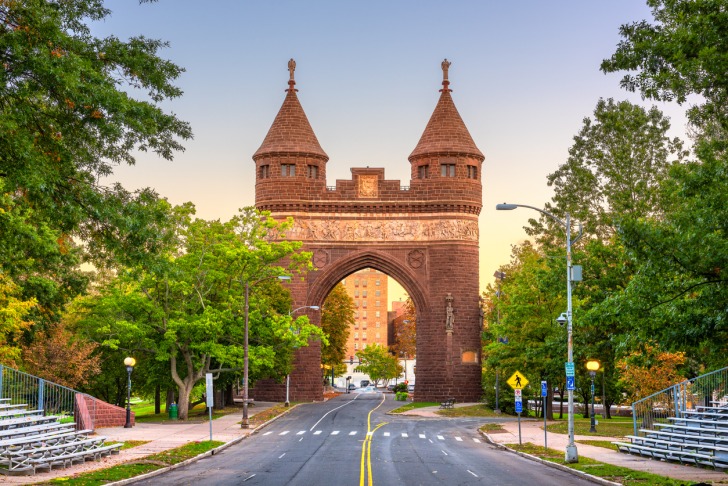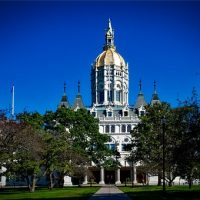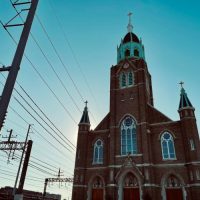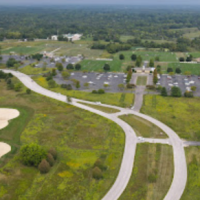Hartford, CT has both urban and country qualities that make it an interesting place to live.
It’s located in the heart of the state, a stone’s throw from major cities like Boston and New York.
The city’s known for its historical value, vibrant culture, and insurance, as strange as that sounds.
With a population of roughly 120,000, there’s room for growth.
If you feel called to this fair city, here’s what you should know about its good points and bad.
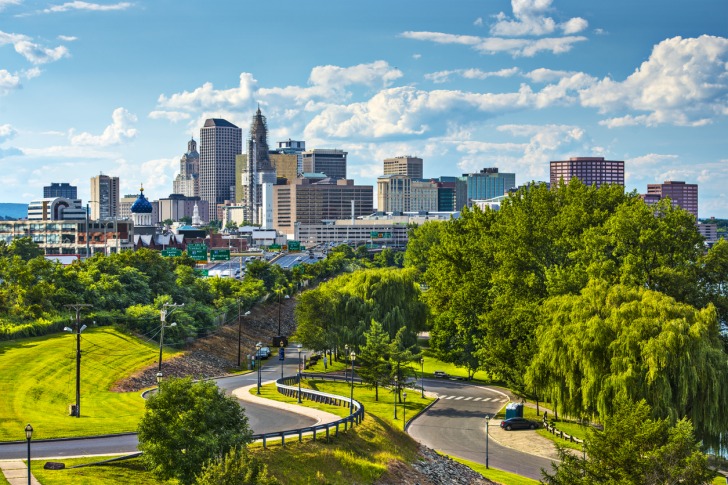
Contents
Pros of Living in Hartford, CT
If you move to Hartford, you can benefit from the city’s:
1. Cultural Heritage
Hartford’s rich cultural heritage gives residents unique experiences to enjoy.
You can visit Mark Twain’s House, the Wadsworth Athenaeum Art Museum, and the Connecticut Science Center.
There’s also the XL Center – a hotspot for conventions, concerts, and sports events that draw thousands annually.
Recreational parks like Bushnell and the Connecticut Riverwalk are popular outdoor attractions.
There’s no shortage of fun or entertainment year-round.
2. Diverse Apartment Living
Hartford offers diverse rental options for those who have no desire to buy.
Over 60% of the city’s residents rent as opposed to purchasing a home or condo.
Apartment rentals can be found everywhere, giving you ample choices of where to call home.
You can enjoy a safe, secure, comfortable living space without the financial burden of homeownership.
Flexible leasing gives you greater freedom to move if your circumstances change, so you don’t feel tied down.
3. Affordable Rental Costs
Compared to other cities in the country, Hartford rents aren’t that bad.
Depending on location, you can find studio apartments for as little as $700+.
The cost of one and two-bedroom apartments ranges between $850 and $1,100.
Expect to pay $1,300 to $1,600 for three and four-bedroom apartments in a fairly decent neighborhood.
By co-oping with a buddy, you can reduce rental costs even more.
4. Diversity in Demographics
Hartford’s diversity ranks higher than both the national and state average.
Of the 120,000 people who live here, many are young adults in their 20s and 30s.
A steady influx of immigrants over the years has brought new traditions and cultures to the area.
Half of the city’s residents profess to be religious, with diverse faiths being represented throughout the community.
Whether you’re Christian, Islamic, Judaic, or other Eastern religions, you can find people to worship with.
5. Location
Hartford’s central location facilitates your commute to other cities and states in the area.
Using I-84 or I-91, you can get to Boston, New York City, and other metropolitan areas.
Residents can live in Hartford and commute to work in Boston or NYC with little inconvenience.
Hartford’s efficient highway, rail, and air (Bradley International Airport) transport services simplify travel.
6. Public Transport System
Hartford’s residents benefit from a multi-faceted public transport system.
The CT Transit Bus System can get you where you need to go anywhere in the city.
The Hartford Dash Shuttle offers free rides to the downtown area on weekdays and for special events.
For travel between cities, there’s CTfastrak, a rapid bus system that travels on bus-only designated roads.
There’s also the New Haven, Hartford, and Springfield Rail Program to take you to nearby communities in Connecticut and Massachusetts.
Boston and NYC are but an Amtrack train ride away.
7. Job Market/Economy
Hartford’s healthy job market has openings in manufacturing, finances, healthcare, and insurance.
Insurance is one of the city’s primary industries with companies like Aetna, Travelers, The Hartford, and United Healthcare being major employers.
Hartford Hospital, Connecticut Children’s Hospital, and Saint Francis are sources of employment for those seeking work in healthcare.
Conning & Co. and Prudential Financial can help you establish a career in finance.
8. Higher Education
Looking for a place to continue your higher education?
Hartford houses some excellent institutions of higher learning.
The U of Hartford and U of Connecticut (Hartford campus) offer degree programs in over 100 majors.
The U of Connecticut in Hartford houses one of the largest law school libraries in the world.
For studies in history, psychology, philosophy, or creative arts, there’s Trinity College.
Hartford’s colleges and universities offer studies in just about any field imaginable.
Cons of Living in Hartford
Along with the pros, there are cons to living in the Constitution State.
If you’re thinking of relocating to Hartford, be prepared to deal with the following:
1. High Cost of Living
Hartford’s cost of living is 5% higher than the U.S. average.
Except for housing, you can expect to pay more for just about everything!
Utility costs are 25% higher than the national average and groceries and clothing are 11% pricier.
You’ll pay more for grooming and entertainment than comparable cities in other parts of the country.
Doctor visits and dental services may be less in Hartford as these costs run 4% lower than the national average.
2. High Poverty Rate
Hartford’s poverty rate is shocking!
About 25% of the population lives below the poverty level.
Compare that to an average poverty rate of 10-13% for other cities in the country.
Household incomes in Hartford are on the low side, averaging around $36,000.
A high poverty rate coupled with low median income is a recipe for trouble.
Which brings us to the topic of crime.
3. High Crime Rate
Hartford seems to have cornered the market on crime in Connecticut, with a crime rate that surpasses that of other cities in the state.
Despite efforts to clean up the city, it still ranks among Connecticut’s six least secure places to live.
Hartford’s crime rate is higher than 90% of all the cities in the country.
If you move here, you’ll have to be on constant alert for your safety!
Statistics show that Hartford residents have a 1 in 28 chance of being a crime victim.
4. High Taxes
Connecticut is known for levying high taxes.
Hartford’s residents are not exempt from the state’s tax laws.
The state’s income tax rate alone is one of the highest in the country.
At 6.35%, the state’s sales tax is also above the U.S. average.
Then there’s the corporate income tax, real estate tax, and gas tax to contend with.
5. It’s Cold and Snowy!
Yes, Hartford is cold and snowy in the winter.
But that’s only 3 ½ months of the year, as winters only last from December to mid-March.
For some people, that’s more than enough!
Especially when temperatures can drop to single-digit numbers and the city can receive as much as 40 inches of snow!
Spring, summer, and fall, however, can be fairly pleasant to balance it out.
Plus, the beautiful fall foliage is to die for!
6. Traffic
Hartford at one point ranked 62 on TomTom’s Traffic Index for cities having the worst traffic.
Bumper-to-bumper traffic here seems to be the norm.
But with two major interstates, I 84 and I 91, running through the city, what can you expect?
In bad weather, there are even greater chances of congestion and traffic jams.
In 2020, drivers spent a whopping 46 hours more in rush hour traffic than anywhere else in the country.
Imagine losing two whole days of your life sitting in a car on the highway!
7. Poor Air Quality
Connecticut’s title of “the tailpipe of the nation” is not given in vain.
Due to wind currents, the state receives air pollution from cars & factories as far as the Midwest.
It’s no wonder Hartford has a place on the infamous list of the 25 most ozone-polluted cities in the country.
Ozone pollution can trigger all kinds of health problems.
If you suffer from asthma, bronchitis, or other respiratory illness, you may want to steer clear of Hartford.
8. Education
Hartford schools suffered a major setback during the pandemic and they’re still recovering.
A good percentage (88%) of Hartford schools are still rated below average.
The district also has a large number of schools lacking in student academic progress.
Only 28% of elementary school children tested at or above proficiency reading levels and 22% at or above proficiency levels for math.
In middle school, the percentage levels were 31% for reading and 21% for math, respectively.
Only 67% of residents in the city have completed a high school education.
9. Rudeness
Connecticut has a reputation for being a “rude and restless” state due to the ill temperament of its residents.
That “rudeness” extends to the capital as well.
Hartford’s residents can be “tough” and “aloof” with each other and particularly strangers.
At one point, the traveler edition of Conde Nast ranked Hartford as the third “unfriendliest” place in the country.
On the list of Business Insider’s 50 Rudest Cities in the U.S., Hartford came in 26th place.
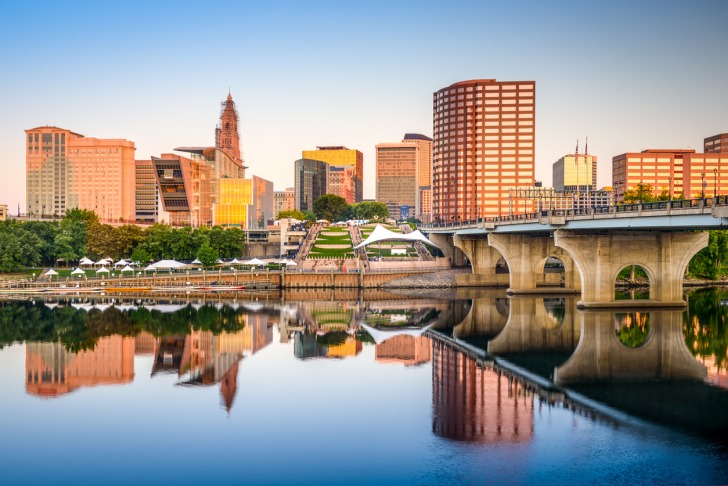
Pros and Cons of Living in Hartford, CT – Summary Table
| Pros of Living in Hartford, CT | Cons of Living in Hartford |
|---|---|
| 1. Cultural Heritage | 1. High Cost of Living |
| 2. Diverse Apartment Living | 2. High Poverty Rate |
| 3. Affordable Rental Costs | 3. High Crime Rate |
| 4. Diversity in Demographics | 4. High Taxes |
| 5. Location | 5. It’s Cold and Snowy! |
| 6. Public Transport System | 6. Traffic |
| 7. Job Market/Economy | 7. Poor Air Quality |
| 8. Higher Education | 8. Education |
| 9. Rudeness |
Hartford Safety Overview
READ THE FULL REPORT: Hartford Safety Review
Safety Index:
- OVERALL RISK: MEDIUM
- TRANSPORT & TAXIS RISK: LOW
- PICKPOCKETS RISK: MEDIUM
- NATURAL DISASTERS RISK: MEDIUM
- MUGGING RISK: MEDIUM
- TERRORISM RISK: LOW
- SCAMS RISK: LOW
- WOMEN TRAVELERS RISK: MEDIUM
Frequently Asked Questions
What is Hartford, CT known for?
Hartford is known as the “insurance capital of the world” due to the massive presence of the insurance industry.
The city headquarters of such insurance giants as Aetna, Cigna, The Hartford, and Travelers.
Needless to say, the insurance industry is one of the city’s largest employers.
What are the demographics of Hartford, CT?
Currently, (2023), Hartford’s population sits around 120,000, but it’s been steadily declining.
Many of the residents are in their 20s and 30s, with the median age around 32.
African Americans make up about 36% of the population, whites about 28%, Asians 2.5%, mixed races 12%, and roughly 21% claim to be “others.”
What is the climate like in Hartford, CT?
Summers are warm, winters are cold, and the sky remains partly cloudy year-round.
Temperatures range in the 80s during the summer and can drop into single digits in winter.
And snow?
You can expect about 40 inches of the white stuff annually.
Are there any natural parks in Hartford, CT?
Hartford is home to 46 natural parks and “parkettes” which cover over 2,000 acres.
Bushnell Park, located downtown, features beautiful green spaces, a historic carousel, and a number of famous monuments.
This majestic park hosts numerous events like the Hartford Marathon and the Greater Hartford Festival of Jazz annually.
What cultural attractions can be found in Hartford, CT?
Hartford is home to numerous cultural attractions.
The Wadsworth Athenaeum Museum of Art is here with a collection of over 50,000 works of art.
There’s also the Mark Twain House, Connecticut Science Center, and XL Center, which hosts dozens of stimulating events annually.
